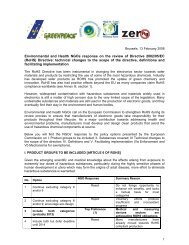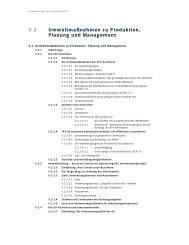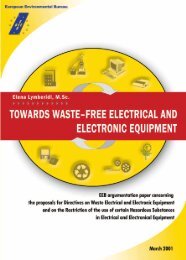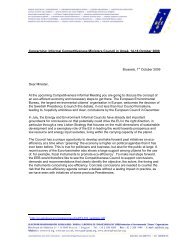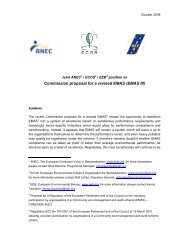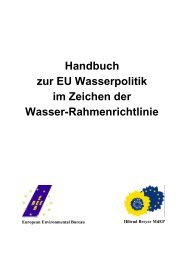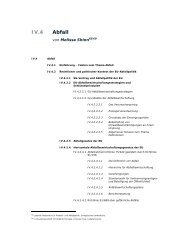Eu Mercury phase out in Measuring and Control Equipment - EEB
Eu Mercury phase out in Measuring and Control Equipment - EEB
Eu Mercury phase out in Measuring and Control Equipment - EEB
You also want an ePaper? Increase the reach of your titles
YUMPU automatically turns print PDFs into web optimized ePapers that Google loves.
REPORT FROM THE CONFERENCE “EU MERCURY PHASE OUT IN MEASURING AND CONTROL EQUIPMENT”Early Cl<strong>in</strong>ical Experience:In Sweden they converted over <strong>in</strong> the late 1980s <strong>and</strong> early 1990s. On a survey approach of theirhospitals: cl<strong>in</strong>ics found no problems with diagnosis or cl<strong>in</strong>ical care by us<strong>in</strong>g the aneroids. To clarifyaneroid devices can be used for people with arrhythmias <strong>and</strong> other special medical conditions. Thismay not be true for oscilloscopic devices because they do the calculation of the diastolic <strong>and</strong>systolic pressure but it is true for the aneroids. Aneroids are good for all of these special medicalconditions if they are calibrated <strong>and</strong> if they are ma<strong>in</strong>ta<strong>in</strong>ed. Published experiences, such as from theMayo Cl<strong>in</strong>ic <strong>in</strong> Rochester, confirm this.When observ<strong>in</strong>g <strong>in</strong> Brazil or develop<strong>in</strong>g countries it was discovered that there were slight underread<strong>in</strong>gsof the aneroid <strong>in</strong>struments (hypertension prevalence 30%, compared with 32% for digital<strong>and</strong> mercury). However, aneroid devices were preferred because they were easily used <strong>in</strong> cl<strong>in</strong>icalsett<strong>in</strong>gs <strong>in</strong> the fields.Electronic devices have to be calibrated as well. One study showed that 21% of patients weremisdiagnosed with uncontrolled hypertension due to the lack of consistency <strong>and</strong> surveillance ofcalibration. In another study aneroid sphygmomanometers were less accurate than mercury basedsphygmomanometers but aga<strong>in</strong> only <strong>in</strong> sett<strong>in</strong>gs <strong>in</strong> which they were not adequately calibrated <strong>and</strong>ma<strong>in</strong>ta<strong>in</strong>ed.The next problem is that most of these products that are on the market are not externally validatedby <strong>in</strong>dependent sources. Further, when models were tested they did not live up to the manufacturerspromises.The WHO 2005 position paper, on review of the literature, said that both mercury <strong>and</strong> aneroidsphygmomanometers have been <strong>in</strong> use for 100 years <strong>and</strong> when work<strong>in</strong>g properly either givesaccurate results. Aneroid sphygmomanometers provide accurate pressure measurements when aproper ma<strong>in</strong>tenance protocol is followed (as is also true for the mercury devices).In the short term the WHO is plann<strong>in</strong>g to develop a mercury cleanup <strong>and</strong> storage procedure. TheWHO says that before f<strong>in</strong>al replacement has taken place, <strong>and</strong> to ensure that new devices conformwith recommended validation protocols, health-care facilities will need to keep mercury as the“gold” st<strong>and</strong>ard to ensure proper calibration of sphygmomanometers. That was <strong>in</strong> 2005 <strong>and</strong> it isclear that this needs to be re-evaluated because this is no longer true given these electronic pressurest<strong>and</strong>ards.In medium <strong>and</strong> long term, hospitals should beg<strong>in</strong> to <strong>phase</strong> <strong>out</strong> mercury <strong>and</strong> assess their <strong>in</strong>ventory.They should <strong>in</strong>crease efforts to reduce the amount of unnecessary mercury equipment <strong>in</strong> general.And f<strong>in</strong>ally <strong>in</strong> the long term, they should look to ban mercury conta<strong>in</strong><strong>in</strong>g devices <strong>and</strong> promote theuse of mercury-free alternatives.The British Hypertension Society <strong>and</strong> others do some <strong>in</strong>dependent evaluation of the various models.There has been an explosion of report<strong>in</strong>g <strong>and</strong> materials <strong>in</strong> the literature both on the variousmanufacturers’ models, the various trade names as well as the overall group <strong>and</strong> types. In 2008 theWorld Medical Association urged the elim<strong>in</strong>ation of mercury conta<strong>in</strong><strong>in</strong>g products for physicians <strong>in</strong>their offices as well as the larger cl<strong>in</strong>ics.38



